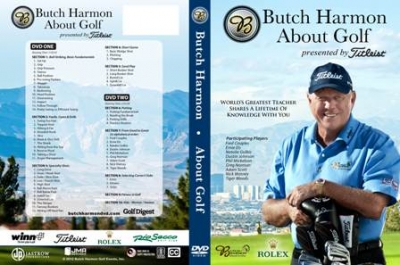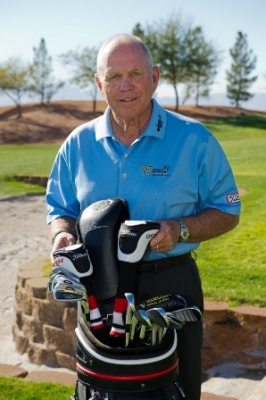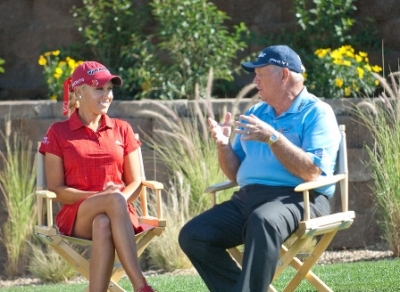By Jeffrey A. Rendall, Photos Courtesy of Butch Harmon Golf Events
LAS VEGAS, NV – It’s something the average golfer can only dream about – a private, four-hour lesson with teaching legend Butch Harmon. It’s about as likely to happen as winning a personal foursome with some of Harmon’s famous students, such as Tiger Woods, Greg Norman and Phil Mickelson.
Fortunately for all us dreamers, Harmon introduced a four-hour instructional DVD, Butch Harmon About Golf (presented by Titleist), which serves as the next best thing. Granted, a two-dimensional video presentation is not quite the same as having Butch stand next to you on the practice tee and providing personal pointers, but it’s also considerably less expensive.
I’ve seen a number of instructional DVDs over the years and take a certain amount of skepticism to each new one, believing that you can’t really learn anything of a technical nature by staring at a television screen.
Thankfully, the Harmon DVD demonstrated that your time expenditure can be worth the investment – and a number of Butch’s tips have already proven useful in application. It should be noted that I also credit Tom Watson (and his instructional DVD) two years ago for completely ‘resurrecting’ my horribly inconsistent golf game with a basic outline of the golf grip.
 |
I had been holding the club too much in the palm of my left hand, which was causing all sorts of problems and frustrations – and it had gotten to the point where I dreaded going to the golf course (which is kind of hard in this line of work). Watson’s instruction to hold the club with your fingers “saved” my game, with instant results -- literally.
For his part, Harmon begins with an overview of his teaching philosophy, which involves helping each person play his (or her) best with the swing he brings to the golf course. Don’t expect Harmon to completely retool your swing and turn you into an Adam Scott-clone – it just doesn’t happen.
And for most of us, getting into those athletic positions isn’t possible anyway.
Similar to other teaching DVDs, Harmon first provides the basics with short sessions on the grip, grip pressure, stance, ball position, pre-swing posture, waggle, takeaway, backswing, head position, downswing, impact, follow-through and finally, “pretty swing vs. efficient swing” – all the while relaying anecdotal stories of wisdom from his career.
Where Harmon excels is his ability to communicate the concepts in language that I could understand, providing practical terms to explain the theories. Many of us recreational golfers have tendencies that Harmon’s seen over his fifty-plus years of teaching the game, and grouping us together is a good means to cover the most ground quickly.
 |
Harmon’s about as famous as you can possibly get in his profession, yet he’s not the least bit snobby or conceited – almost like a favorite uncle showing you the ropes, and offering a little tough love occasionally, too.
Section 2 of Harmon’s lectures is Faults, Cures & Drills, includes segments on swing too fast, topped shot, hitting it fat, the dreaded hook, slice, hook & slice drill, the shank, hitting from the top, reverse pivot, taking a divot and anger management -- the last one clearly aimed at helping us all get past a bad shot.
Section 3 deals with specialty shots. As you would probably gather, here, Harmon talks about different kinds of lies, how to curve the ball both ways and how to handle difficult situations like hitting off hard pan and fairway bunkers.
It’s also where Harmon demonstrates the famous “Stinger” shot that Tiger Woods employed during his hot streak of the early 2000’s – and now curiously, no longer uses.
Sections 4, 5 and 6 cover short game, sand play and putting respectively.
 |
From there, the DVD features From Good to Great (Section 7), short parts with some of the past and current professionals that Harmon’s tutored – Fred Couples, Ernie Els, Natalie Gulbis, Dustin Johnson, Phil Mickelson, Greg Norman, Adam Scott, Nick Watney and Tiger Woods. Each pro discusses how Harmon’s helped them, and shows that even the best players in the world still need a guiding hand.
The series concludes with sections 8, 9 and 10, selecting correct clubs (with a shout-out to Titleist on all the latest equipment), fitness in golf and a series of sessions dealing with junior golfers, women golfers (including actress Anne Archer!) and senior golfers.
Most helpful
The areas I found particularly helpful concerned “fixes” and “specialty shots.” Having covered several golf schools in the past, I’ve embraced a number of different swing thoughts which have evolved into a healthy host of bad habits.
One especially troublesome problem involves a re-occurring slice with the driver, which I’ve occasionally been able to correct with adjustable club heads – and aiming considerably to the left.
 |
Harmon says that most of the things we do to correct slices (in our subjective minds) only exacerbate the malaise, and he’s right. His cure involved a drill that would allow for a correct swing-plane, allowing me to close the club face and hit straighter shots.
I’m not sure it’s a permanent cure, but initial trials were successful. The driver will remain the scariest and most dangerous club in the bag, but at least now I have a good idea of what caused (and fixed) that awful slice.
I also liked Harmon’s explanation of how to hit draws and fades – simply by changing your stance slightly and using your normal swing. Draws are still somewhat illusive for me, but I was able to fade my way out of trouble on several different occasions using Harmon’s suggestions.
As with all aspects of golf, practice is required to hone the concepts.
Short Game
 |
In the course of presenting his teaching methods, Harmon recommends “practicing what you’re not good at,” which is sage advice for most of us. I’m certainly guilty of going to the range and focusing on short-irons and putting, two areas where I’ve always had some success – a comfort zone.
His pitching and chipping lessons will help develop that “zone” with short-shots, which is an area most average players tend to under-practice if not outright ignore. There’s been many a time where the practice tees have been completely full and the short-game area is practically empty. Harmon makes these shots much less tedious and frightening at the same time.
Summing it up
I would recommend taking notes on Harmon’s lessons and trying a few concepts at a time when you go out to practice – and then maybe bring a swing thought or two when you actually go to play.
Trying to do too much is certainly not something that’s good for your golf game, and I’m sure Harmon himself would counsel against it.
Take Butch’s advice to heart, and you’ll likely end up playing better – and having more fun along the way.
Details:
The DVD is available online only: www.butchharmondvd.com .
| Related Links | Comments on this article? | |
|
Maryland National Golf Club Hollow Creek Golf Club Rocky Gap Resort PB Dye Golf Club in Ijamsville Whiskey Creek Golf Club |
E-mail Jeff Rendall, Editor: jrendall@golftheunitedstates.com |











